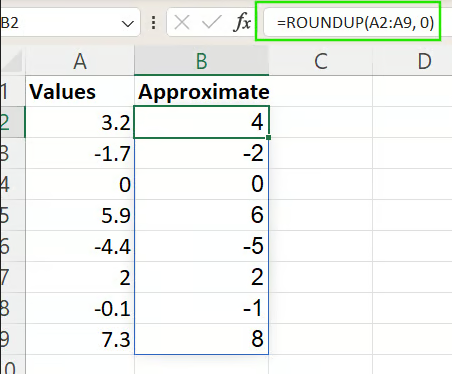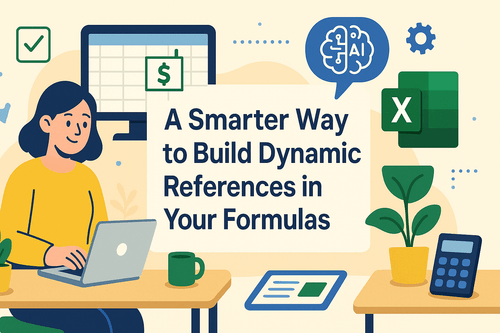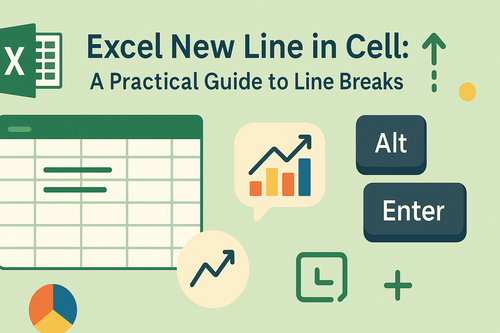Key Takeaways
- Rounding up numbers is essential for business scenarios like pricing strategies, budget calculations, and inventory management where underestimation is not an option
- Excelmatic's AI approach eliminates the need to memorize ROUNDUP syntax by letting you round up numbers using simple language commands
- Compared to traditional ROUNDUP(), Excelmatic handles complex rounding scenarios including conditional logic and array operations with intuitive instructions
- For business decision-makers, adopting AI tools means faster financial calculations and more accurate business projections without technical Excel knowledge
The ROUNDUP() function is unique among Excel’s rounding options because it always rounds away from zero. This means the result is always greater in magnitude (more positive or more negative) than the original number, no matter what the digit is after the rounding position.
In this article, we'll walk through the traditional way to round up numbers using the ROUNDUP() function. We'll also introduce a modern, AI-powered alternative that can get the job done faster and without memorizing any formulas.
The Traditional Method: How to Round Up with Formulas
Let's start with the classic Excel function. Here is a quick example: The following function rounds up 76.345 to 77, the nearest whole number.
=ROUNDUP(76.345, 0)

How Excel ROUNDUP() Works
Here are the arguments that are used with the ROUNDUP() function:
=ROUNDUP(number, num_digits)
Where:
number: The value you want to round up.num_digits: Sets how many decimal places or digits to the left of the decimal to round to.
A little more about that num_digits argument: It controls how the numbers are rounded up.
- When it's positive: Rounds up to a specified number of decimal places. For example,
=ROUNDUP(3.14159, 2)returns 3.15. - When it's zero: Rounds up to the nearest whole number. For example,
=ROUNDUP(3.14159, 0)returns 4. - When it's negative: Rounds up to the left of the decimal, such as to the nearest ten, hundred, etc. For example,
=ROUNDUP(314.159, -2)returns 400.
When to Use ROUNDUP() Instead of ROUND()
While Excel’s ROUND() function rounds numbers up if the digit being dropped is 5 or greater, and down if it is less than 5, ROUNDUP() always rounds away from zero.
Use ROUNDUP() when precision demands rounding upward regardless of value, such as:
- Calculating shipping weights to ensure you never charge too little.
- Setting price floors to prevent prices from falling below a set threshold.
- Rounding up time blocks for billing or scheduling.
It is important to note that, unlike ROUND(), ROUNDUP() ignores whether the digit is 5 or greater, thus always increasing the number's magnitude.
Two Common ROUNDUP() Examples
Let’s explore the practical applications of the ROUNDUP() function.
Round up monetary values
Use ROUNDUP() to ensure you never underestimate amounts like prices or costs. The function below rounds up the number to 45.13.
=ROUNDUP(45.126, 2)

Round up to nearest 10
The ROUNDUP() function can round integers to the next multiple of 10. For example, the function below rounds up 67 to 70.
=ROUNDUP(67, -1)

The AI-Powered Alternative: Rounding Up with Excelmatic
While ROUNDUP() is powerful, remembering its syntax—especially the num_digits argument—can be tricky. For a faster, more intuitive approach, you can use an AI Excel Agent like Excelmatic.

With Excelmatic, you simply upload your spreadsheet and describe what you need in plain English. The AI handles the rest.
Let's see how Excelmatic tackles the same examples:
Round up monetary values: Instead of
=ROUNDUP(45.126, 2), you would just tell Excelmatic:For the price column, round all values up to two decimal places.
Round up to nearest 10: Instead of the slightly confusing
=ROUNDUP(67, -1), you can say:Round up the numbers in the quantity column to the nearest 10.
Excelmatic interprets your request and performs the correct calculation across your entire dataset instantly, without you needing to write or drag a single formula.
Why Choose the AI Method?
| Feature | Traditional ROUNDUP() Formula |
Excelmatic (AI Agent) |
|---|---|---|
| Effort | Requires memorizing function and syntax. | Just describe your goal in plain language. |
| Speed | Fast for single cells, but can be tedious for complex tasks. | Instant results for entire datasets, including complex logic. |
| Complexity | Nesting formulas (IF, VLOOKUP) can become messy. |
Handles complex, multi-step tasks with a single prompt. |
| Error-proneness | Prone to syntax errors like incorrect num_digits or parentheses. |
Eliminates syntax errors, interpreting your intent directly. |
How ROUNDUP() Differs from Similar Functions
Excel offers several rounding functions. Here's how ROUNDUP() compares to others, which is good knowledge to have, even when using AI tools:
| Function | Behavior | Example |
|---|---|---|
ROUNDUP() |
Always rounds up, away from zero | =ROUNDUP(2.1, 0) → 3 |
ROUND() |
Rounds up or down based on value | =ROUND(2.5, 0) → 3 |
ROUNDDOWN() |
Always rounds down, toward zero | =ROUNDDOWN(2.9, 0) → 2 |
CEILING() |
Rounds up to the nearest multiple | =CEILING(7, 5) → 10 |
INT() |
Rounds down to the nearest integer | =INT(-4.5) → -5 |
MROUND() |
Rounds to nearest multiple, up or down | =MROUND(2.3, 0.5) → 2.5 |
More Advanced Cases: Formulas vs. AI
The ROUNDUP() function becomes even more useful when combined with other functions. But this is also where AI tools truly shine.
Nesting inside calculations
Formula Method: To round up the result of a calculation, you nest the functions. The formula below rounds the product of A2 and B2 up to 2 decimal places.
=ROUNDUP(A2 * B2, 2)

Excelmatic Method:
Create a new column by multiplying column A and column B. Then, round the results up to two decimal places.
ROUNDUP() in conditional logic
Formula Method: You can apply rounding only under certain conditions using IF(). The formula below rounds A2 up to the nearest whole number only if it's positive.
=IF(A2 > 0, ROUNDUP(A2, 0), "")

Excelmatic Method:
If the value in column A is positive, round it up to the nearest whole number. Otherwise, leave the cell blank.
Working with arrays
Formula Method: In modern Excel, ROUNDUP() can be applied to arrays. The formula below returns an array of each value in A2:A9 rounded up.
=ROUNDUP(A2:A9, 0)

Excelmatic Method: This is the default behavior. A prompt like "Round up the values in column A to the nearest whole number" will be applied to the entire column automatically.
Common Pitfalls and Tips
Whether using formulas or AI, it's good to know these details:
- Negative numbers round further from zero:
ROUNDUP()always rounds away from zero. For example,=ROUNDUP(-2.3, 0)results in -3, not -2. - Rounding inflation: When applied repeatedly,
ROUNDUP()can bias values higher. It's often best to round at the final stage of a calculation. ROUNDUP()vs.CEILING(): They are not the same. UseCEILING()when rounding to a specific increment (like multiples of 5) andROUNDUP()when rounding based on decimal places.
Conclusion
The ROUNDUP() function is a fundamental tool in Excel for when values must always round upward. It’s reliable for budgeting, pricing, and forecasting.
However, as we've seen, AI agents like Excelmatic offer a more streamlined and intuitive path to the same result. By translating plain English into accurate results, they eliminate the need to memorize function syntax and simplify complex, multi-step tasks.
For mastering Excel, it's valuable to understand how functions like ROUNDUP() work. But for getting work done quickly and accurately, embracing AI tools is the smarter way forward.
Ready to simplify your Excel rounding tasks? Try Excelmatic today and experience the power of AI-driven calculations.
How is ROUNDUP() different from ROUND()?
ROUNDUP() always rounds away from zero, while ROUND() rounds up or down depending on the digit being removed.
What happens when I use a negative num_digits in ROUNDUP()?
The number rounds up to the left of the decimal. For example,=ROUNDUP(123, -1) rounds to 130.
Does ROUNDUP() work with time or dates?
Not directly. For time rounding, use MROUND(), CEILING(), or time-specific formulas instead.
Is ROUNDUP() the same as CEILING()?
No. CEILING() rounds up to a specific multiple, while ROUNDUP() rounds by digit place.






